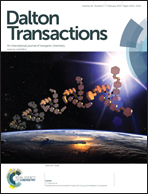Self-enhanced electrogenerated chemiluminescence of ruthenium(ii) complexes conjugated with Schiff bases†
Abstract
In this work, we obtain two ruthenium(II) complexes with Schiff base cavities that exhibit significantly enhanced electrochemiluminescence (ECL) intensity and quantum efficiency due to Ru(bpy)32+ in aqueous solution, without the addition of tri-n-propylamine (TPrA). The great increase in ECL intensity is confirmed to be due to the electrochemical oxidation of phenolic hydroxyl groups and the resonant structure of imino radicals. Thus, the electrons are transferred intramolecularly to the Ru(III) center, leading to efficient generation of the excited state of Ru(II)*. Subsequently, we find that Co2+ bonding with the salen cavity can selectively and quickly quench the ECL signal. Furthermore, we study the mechanism of the process by which Co2+ hinders the oxidation of phenolic groups and blocks the electron transfer from imino radicals to the Ru center. Thus, a highly sensitive and selective ECL probe for the recognition of Co2+ was developed with a stable response over a concentration range of 0.9 μM to 6.3 μM and a detection limit as low as 21 nM.


 Please wait while we load your content...
Please wait while we load your content...